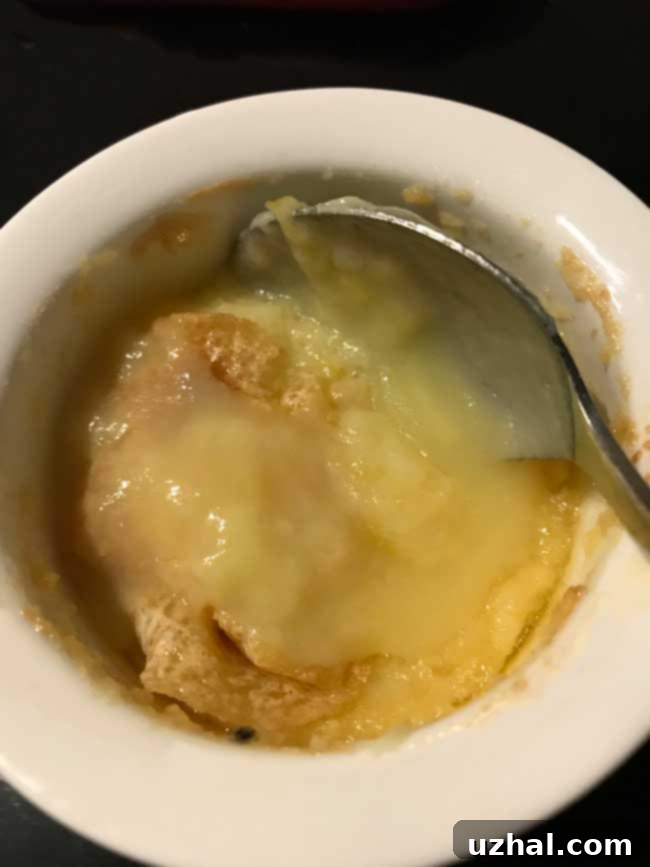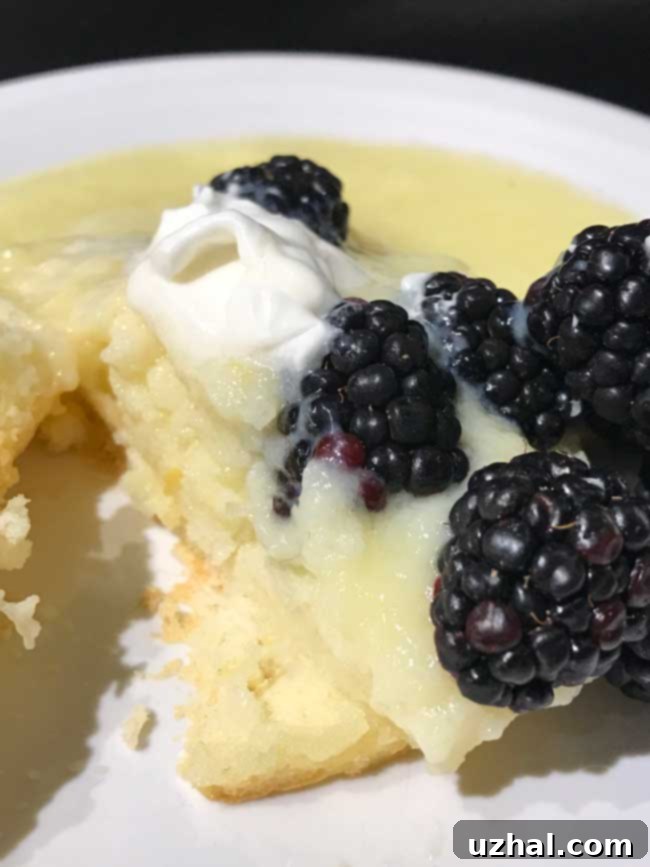Baked Lemon Pudding Cakes: A Zesty, Elegant Individual Dessert Perfect for Any Occasion
There’s something truly magical about a dessert that surprises you with its hidden delights. Years ago, I shared a recipe for a delightful lemon pudding cake, traditionally baked in a single 8-inch square pan. While that version holds a special place, today we’re elevating the experience with a similar, yet wonderfully refined, approach: individual Baked Lemon Pudding Cakes. Instead of a single large pan, these exquisite treats are baked in six 6-oz custard cups, creating perfect, personal portions of citrusy bliss.

This fantastic recipe hails from the esteemed pages of The Good Housekeeping Illustrated Book of Desserts, a trusted source for timeless culinary gems. It calls for a simple yet powerful lineup of ingredients: fresh lemons (both juice and zest), eggs, milk, a touch of flour for structure, sugar for sweetness, and a little melted butter for richness. What makes these individual lemon pudding cakes truly stand out? Several reasons, actually. Firstly, they strike a beautiful balance, being far less rich than many other desserts, making them an ideal choice when you crave something sweet but light. Secondly, they exude an undeniable elegance without demanding excessive effort or fuss, making them perfect for entertaining guests or simply treating yourself to a sophisticated dessert. And, if I may add a third, highly compelling reason: whenever I encounter a bounty of fresh berries, my mind immediately jumps to, “What exquisite dessert will best complement these vibrant flavors?” These lemon pudding cakes are the answer! So, if you spot raspberries or blackberries on sale, consider it a sign – it’s time to whip up a batch of these glorious lemon pudding cakes.

The recipe is thoughtfully designed to yield six individual servings, making it perfect for a small gathering or to enjoy throughout the week. Should you find yourself needing fewer, perhaps just three servings, the recipe is incredibly forgiving and halves perfectly with no significant adjustments required. In such a scenario, you can easily use a smaller 8-inch pan for your water bath instead of the standard 9×13 inch baking pan. This flexibility ensures you can always enjoy these delightful lemon puddings, whether for a crowd or a quiet evening at home.
Update: While often enjoyed warm, a delightful discovery has been made – these individual lemon puddings are equally delicious, if not even more refreshing, when served chilled. This versatility adds another layer of appeal, making them a perfect dessert for any season.
The Allure of Individual Lemon Puddings: Convenience Meets Elegance
In a world where presentation and convenience often go hand-in-hand, these individual baked lemon pudding cakes truly shine. Baking them in separate custard cups or ramekins eliminates the need for slicing and serving a larger cake, ensuring each guest receives a perfectly portioned, visually appealing dessert. This approach not only makes serving effortless but also provides a delightful element of surprise as the light, golden cake top gives way to a luscious, self-saucing lemon custard below. Imagine presenting a ramekin to each diner, topped with a dusting of powdered sugar and a few fresh berries – it’s an instant elevation to any meal.
Beyond their elegant presentation, the convenience factor cannot be overstated. These lemon puddings are ideal for meal prepping individual desserts for a week, or for preparing ahead of a dinner party. They bake beautifully, hold their structure, and their flavors only deepen as they cool. This makes them a fantastic option for busy home cooks who want to impress without being tethered to the kitchen at the last minute. The mere act of unmolding (or simply serving directly in the ramekin) and garnishing is all that’s required to bring a sophisticated end to any culinary experience.
The Science Behind the Self-Saucing Magic: A Culinary Spectacle
One of the most captivating aspects of these lemon pudding cakes is their unique ability to create two distinct layers during baking: a light, airy cake on top and a rich, creamy lemon custard at the bottom. This isn’t just a happy accident; it’s a fascinating culinary transformation. The magic begins when the batter, a delicate suspension of ingredients, is poured into the ramekins. During the baking process, particularly within the gentle heat of a water bath, the lighter elements, mainly the whipped egg whites, rise to the top, forming a soufflé-like, spongy cake layer. Meanwhile, the denser, more liquid components – the lemon juice, milk, and melted butter – settle to the bottom, where they cook slowly and transform into a silken, tangy pudding. This natural separation results in a delightful textural contrast that truly sets this dessert apart from a standard cake or pudding.
The role of the separated eggs is crucial here. Beating the egg whites to stiff peaks incorporates air, which expands in the oven, creating the light, fluffy cake layer. The egg yolks, mixed with the other liquid ingredients, contribute to the richness and smooth texture of the custard. This clever use of ingredients and baking technique ensures a dessert that is both intriguing to prepare and incredibly satisfying to eat, offering a dual experience in every spoonful.
Mastering the Water Bath (Bain-Marie): Essential for Perfection
The secret to achieving the incredibly smooth, tender texture and perfect self-saucing consistency of these individual lemon pudding cakes lies in the water bath, or bain-marie. This technique is non-negotiable for custard-based desserts, and here’s why:
- Even, Gentle Heat: Direct oven heat can be too aggressive for delicate custards, causing them to cook too quickly, curdle, or develop an uneven texture. The water bath creates a moist, insulating environment around the ramekins, ensuring a slower, more even cooking process. This prevents the edges from setting faster than the center and helps maintain a uniform temperature throughout the custard.
- Preventing Cracks and Dryness: The steam generated by the hot water keeps the surface of the puddings moist, preventing them from drying out or cracking on top. This is especially important for the delicate cake layer, ensuring it remains tender.
- Perfect Texture: The gentle cooking from the water bath allows the egg proteins to set slowly, resulting in an incredibly smooth, creamy, and velvety custard layer beneath the light cake top. Without it, you might end up with a rubbery or tough pudding.
Setting up your water bath is straightforward: Place your greased custard cups into a larger baking pan (a 9×13 inch pan for six ramekins, or an 8-inch pan for three). Once the pan is on the oven rack, carefully pour very hot water (boiling or near-boiling is best, though hot tap water works in a pinch) into the larger pan until it comes about halfway up the sides of the custard cups. Be careful not to splash water into the batter. This simple step makes all the difference in achieving individual lemon puddings that are truly spectacular.
Key Ingredients: Zest, Juice, and Everything Nice for Zesty Lemon Puddings
Every great recipe relies on quality ingredients, and these baked lemon pudding cakes are no exception. The star, of course, is the lemon, and using fresh, vibrant lemons is paramount. Here’s a closer look at what each component contributes:
- Fresh Lemons (Zest and Juice): This is where the bright, tangy flavor truly comes from.
- Lemon Zest: The zest contains aromatic oils that provide a concentrated, fragrant lemon flavor without adding acidity. It gives the puddings their signature bright aroma. Make sure to only zest the yellow part, avoiding the bitter white pith.
- Lemon Juice: The juice provides the essential tartness and tang that balances the sweetness of the sugar. Freshly squeezed lemon juice is non-negotiable; bottled juice simply won’t deliver the same vibrant flavor.
- Eggs (Separated): Eggs play a dual role in creating the unique two-layered structure.
- Egg Whites: Whipped to soft or stiff peaks, they incorporate air into the batter, which becomes the light, soufflé-like cake layer on top. They contribute to the pudding’s lift and airy texture.
- Egg Yolks: The yolks provide richness, color, and act as an emulsifier, contributing to the creamy texture of the custard layer.
- Whole Milk: The milk forms the liquid base of the custard, contributing to its creamy texture and moisture. Whole milk is recommended for the best flavor and richness.
- Granulated Sugar: Sweetness is crucial to balance the tartness of the lemon. Sugar also helps tenderize the cake layer and ensures the custard sets properly.
- All-Purpose Flour: Just a small amount of flour helps stabilize the pudding and gives the cake layer some structure, preventing it from collapsing entirely.
- Melted Salted Butter: Butter adds a lovely richness and tenderness to the pudding, enhancing its mouthfeel and flavor profile. Using salted butter can also help balance the sweetness.
- Salt: A pinch of salt is essential to enhance all the other flavors, making the lemon taste brighter and the dessert more balanced overall.
By understanding the role of each ingredient, you can appreciate the thoughtful design of this recipe and ensure you’re using the best quality components for an exceptional outcome.
Baking Tips for Success: Achieving Perfect Individual Lemon Puddings
While the recipe itself is straightforward, a few key tips can ensure your individual baked lemon pudding cakes turn out perfectly every time:
- Grease Ramekins Thoroughly: Don’t skimp on greasing your custard cups. A good layer of butter or non-stick spray will prevent the puddings from sticking and ensure easy serving, whether you’re unmolding them or simply scooping directly from the cup.
- Whip Egg Whites Correctly: The key to the soufflé-like top layer is perfectly whipped egg whites. Ensure your bowl and beaters are impeccably clean and free of any grease, as even a tiny speck can prevent the whites from whipping properly. Beat until soft peaks form before gradually adding sugar, then continue beating until stiff, glossy peaks are achieved and the sugar is dissolved.
- Gentle Folding is Key: Once your egg yolk mixture is ready and your egg whites are stiff, the most crucial step is gently folding the whites into the yolk mixture. Use a rubber spatula and a delicate hand, lifting from the bottom of the bowl and folding over the top. Overmixing will deflate the egg whites, resulting in a dense, rather than airy, cake layer.
- Hot Water for the Water Bath: As mentioned, using very hot or boiling water for the bain-marie is best. This helps the oven temperature stabilize more quickly and ensures the gentle, even cooking that custards require.
- Doneness Cues: Look for the tops to be golden brown and firm to the touch. A gentle jiggle of the ramekin should show the center of the cake layer set, while the underlying custard will still have a slight, delicate quiver. An inserted skewer into the cake layer should come out mostly clean.
- Cooling Time: Allow the puddings to cool on a wire rack before serving. This allows them to fully set and for the flavors to meld. They can be enjoyed warm or, as discovered, chilled!
Follow these tips, and you’ll be well on your way to creating consistently perfect and utterly delicious individual lemon pudding cakes.
Serving Suggestions and Delicious Pairings
These individual baked lemon pudding cakes are delightful on their own, but they truly sing when paired with complementary toppings and enjoyed at the right temperature. As the update suggests, their versatility means they are wonderful both warm and cold.
- Fresh Berries: This is a classic and highly recommended pairing. The tartness of the lemon is beautifully complemented by the natural sweetness and slight acidity of fresh berries.
- Raspberries: Their vibrant color and delicate tartness make them a perfect match.
- Blueberries: Offer a burst of sweetness and a lovely textural contrast.
- Blackberries: Their rich, deep flavor and slight tanginess work wonderfully with lemon.
- Mixed Berries: A medley of seasonal berries creates a stunning and delicious presentation.
- Whipped Cream: A dollop of freshly whipped cream adds a luxurious creaminess and helps to mellow the lemon’s tang. A hint of vanilla or a touch of sugar in the whipped cream can elevate it further.
- Powdered Sugar: For a simple yet elegant finish, a light dusting of powdered sugar (confectioners’ sugar) over the cake tops adds a touch of sweetness and a beautiful visual appeal.
- Mint Sprig: A fresh mint sprig provides a lovely aromatic garnish and a touch of contrasting color.
- Lemon Curd: For the ultimate lemon lover, a small spoonful of extra lemon curd on top or on the side can intensify the citrus flavor.
- Serving Temperature:
- Warm: Enjoying them warm straight from the oven (after a short cooling period) highlights the custardy interior and the delicate cake top.
- Chilled: Serving them cold (as discovered in the update) transforms them into a refreshing, light dessert, perfect for warmer weather or as a palate cleanser. The texture of the custard becomes firmer and more akin to a rich panna cotta.
These puddings are versatile enough for any occasion, from a casual family dinner to a sophisticated dinner party. Their individual portions make them an excellent choice for entertaining, ensuring a perfectly presented dessert for every guest.
Storage and Make-Ahead Options for Lemon Pudding Cakes
The beauty of these individual baked lemon pudding cakes extends to their convenience in terms of storage and make-ahead potential. Whether you’re planning a party or simply want to have a delightful treat on hand, here’s how to manage them:
- Storage: Once completely cooled, these lemon puddings should be covered and refrigerated. Store them directly in their ramekins. They will maintain their quality and delicious flavor for up to 3-4 days in the refrigerator. The cake top might soften slightly, but the overall texture and taste will remain excellent.
- Make-Ahead: These puddings are an excellent make-ahead dessert. You can bake them a day or two in advance and keep them refrigerated. When it’s time to serve, you have a few options:
- Serve Cold: As noted in the update, they are fantastic chilled. Simply take them out of the refrigerator, garnish, and serve.
- Serve Warm: If you prefer them warm, you can gently reheat them in a low oven (around 250°F / 120°C) for 10-15 minutes, or until just warmed through. Be careful not to overheat, as this can dry out the cake or alter the custard’s texture. Alternatively, you can briefly warm individual puddings in the microwave for 20-30 seconds.
- Freezing: While technically possible, freezing is generally not recommended for these puddings. The delicate texture of the custard can become grainy or watery upon thawing, and the cake layer might lose its airy quality. It’s best to enjoy them fresh or within a few days of refrigeration.
Having these individual lemon pudding cakes ready in the fridge means you’re always prepared for a sweet craving or an unexpected guest, making them a true culinary asset.
Recipe

Baked Lemon Cake Puddings
Cookie Madness
Pin Recipe
Ingredients
- 2 medium size lemons
- 2 large eggs separated
- ¼ teaspoon salt
- ¾ cup sugar
- 1 cup whole milk
- 3 tablespoons flour
- 2 tablespoons salted butter melted
Instructions
-
Preheat oven to 350 degrees F. Grease six 6-oz custard cups.
-
Zest the lemons and measure out 1 tablespoon of zest.
-
Juice the lemons and measure out ⅓ cup of juice.
-
In a small mixing bowl using a handheld electric mixer, beat the egg whites and salt util soft peaks form. Gradually sprinkle in ½ cup sugar, beating until whites are stiff and sugar has dissolved.
-
In a large bowl, using the electric mixer at medium, beat the egg yolks and remaining ¼ cup of sugar until blended. Add the lemon zest, lemon juice, milk, flour and melted butter. Beat scraping sides of bowl with a rubber spatula.
-
With a heavy duty scraper, fold beaten egg whites into yolk mixture.
-
Carefully pour the batter into the greased custard cups (or ramekins).
-
Set the cups in a 13×9 inch baking pan. Place on oven rack and pour boiling water (I used very hot water from the tap) into the pan so that it comes halfway up sides of custard cups. Bake for 40 to 45 minutes until tops are golden brown and firm.
-
Let cool on a wire rack.
There’s truly nothing quite like the burst of fresh lemon in a dessert, and these individual pudding cakes deliver on all fronts: flavor, elegance, and ease. They are a testament to how simple ingredients, combined with a clever baking technique, can create a dessert that feels both comforting and sophisticated. Whether you’re a long-time fan of lemon desserts or looking to try something new, these individual baked lemon pudding cakes are sure to become a cherished addition to your recipe collection. Gather your ingredients, prepare your ramekins, and get ready to experience a truly delightful treat. Happy baking!
